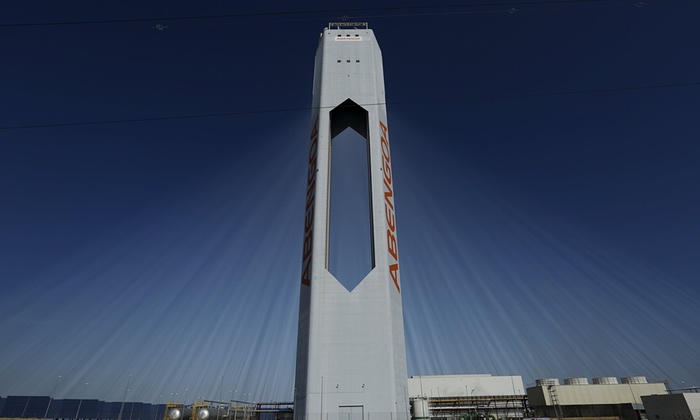$29 billion Vaporized
As is well-known, Spain is one of the countries in the euro area’s periphery that has been thoroughly bankrupted by its decision to join the euro area and enjoy an artificial credit expansion-induced boom as its interest rates initially collapsed. This was aided and abetted by the ECB, which sat idly by as the euro area’s true money supply exploded into the blue yonder with annualized growth rates ranging from 6% to 18% during the boom years.

Tower at Abengoa solar plant in Sanlúcar la Mayor, near Seville in Spain.
Photo credit: Marcelo Del Pozo / Reuters
And why not, the bizarre “inflation target” set by the bureaucrats was after all almost hit most of the time (HICP annualized growth actually fluctuated between 2% and 4% during the boom period, so they missed their target “slightly”). Currently the ECB is trying to make up for this faux-pas, by redistributing wealth from the region’s battered savers to its over-indebted governments and insolvent banks by means of expanding the money supply even more and suppressing interest rates well into total economic perversion territory.

Euro area – annual money TMS growth rates during the boom period (in the green box)
This strategy will “buy time” and ensure that assorted bankruptcies will eventually turn out to be even more profound and devastating than they might have been otherwise. But who are we to criticize our well-versed central planning bien pensants? Haven’t they proved over and over again what geniuses they are?
In the meantime the fall-out from the preceding boom-bust sequence continues to make landfall, and not surprisingly, one of the capital-wasting boondoggles most beloved by Europe’s central planners, social engineers and wealth redistributors has just crashed and burned in Spain.
This lengthy intro was necessary to properly set out the background: since Spain’s government and banking system are de facto insolvent and their temporary rescue has been tied to conditions, Spain can no longer subsidize many of the pet projects of social engineers and the vast hordes of cronies they have hitherto kept in bread by enlisting the involuntary help of taxpayers. In a way, it is a case of socialism running out of people to loot.
Solar energy has surely come a long way in recent years, as technological progress has undoubtedly improved its economics. Evidently though, the improvement isn’t sufficient yet to make it actually viable. One would think that it makes sense to deploy it in places that are sunny most of the time (such as, well, Spain), but even there, it evidently depends on subsidies.
People often forget that it actually costs energy to produce solar panels. Whether they will in turn produce enough energy during their lifetime to make this investment viable remains questionable. It remains questionable precisely because so many companies in the sector depend both directly and indirectly on a vast variety of government subsidies (including the introduction of inane trade barriers to the detriment of consumers).













Leave A Comment